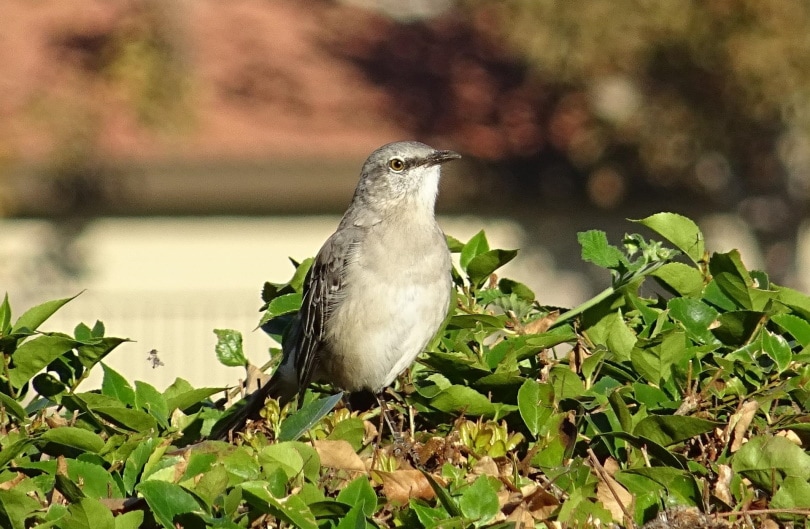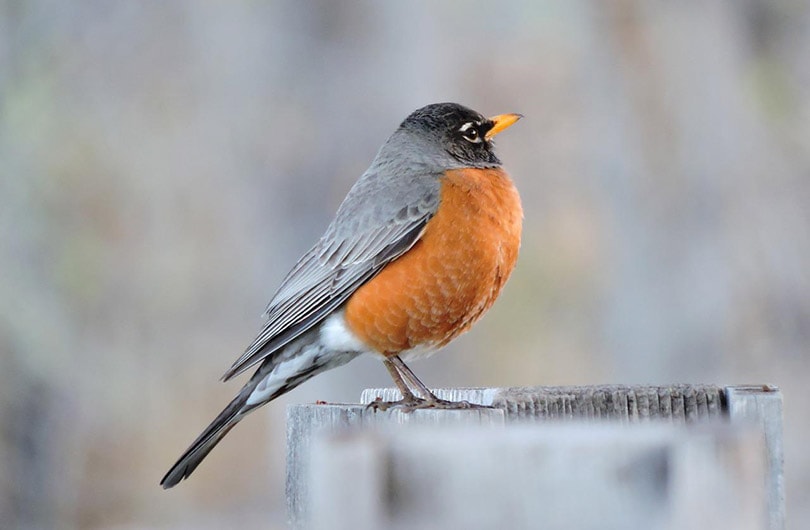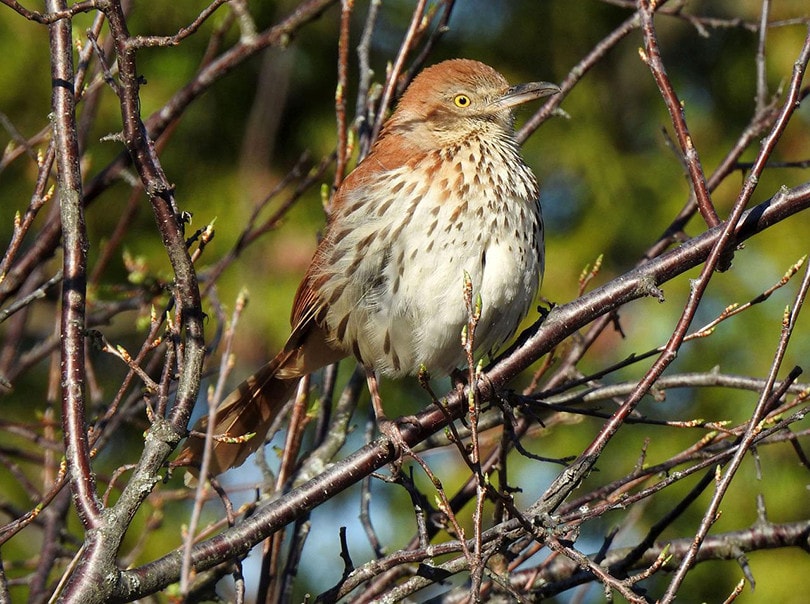22 Common Backyard Birds in South Carolina (with Pictures)
Last Updated on

Gorgeous year-round weather brings a litany of bird species to South Carolina. For residents, there’s a rare opportunity to supply action, color, and music to the yard with stocked feeders and sturdy nest boxes.
We will look at some of the more common backyard birds in South Carolina below and detail how you can make them frequent fixtures around your property.

The 22 Common Backyard Birds in South Carolina
1. Carolina Wren

| Size: | 7”–5.5” |
| Wingspan: | 4” |
| Coloration: | Reddish-brown back and tail feathers, creamy tan underside |
The official state bird of South Carolina, the Carolina Wren is a year-round resident in warm-weather regions along the eastern United States. You can find it nesting anywhere from swamps and forests to eaves and window sills.
A model of fidelity, this solitary wren mates for life. You can hear the “tea-ket-tle” sound of the male bird’s cry at all times of the year. If it’s the type of sound you enjoy waking up to, you can attract them with a suet feeder or brushy patches around the lawn where they can hide.
2. Northern Cardinal

| Size: | 3”–9.1” |
| Wingspan: | 8”–12.2” |
| Coloration: | Male: bright red; Female: light brown with hints of copper and red |
The Northern Cardinal is one of the most identifiable red birds in South Carolina and the rest of the eastern United States. The male’s attractive red features bring striking highlights to the yard, which might explain why the Cardinal is the official state bird of seven states!
Cardinals live year-round in dense brushy areas on forest edges, but they’re no strangers to backyards and city parks. Attract them to your property with a tray feeder full of black sunflower seeds, cracked corn, nuts, and various fruits and berries.
3. Carolina Chickadee

| Size: | 9”–4.7” |
| Wingspan: | 9”–7.9” |
| Coloration: | Gray wings and tail, white underside, black cap and bib |
The Carolina Chickadee is yet another year-round resident in the southeastern United States. These tiny South Carolina songbirds sometimes hybridize with Black-capped chickadees. Hybrids can sing the songs of both species.
Intelligent and outgoing, the Carolina Chickadee will live in forests, parks, and yards. They feed on insects, black oil sunflower seeds, peanuts, and suet, among other things. Since they can’t chew, they’ll take one oversized kernel at a time to a branch to crack open and consume. Draw them to your yard with a feeder and give them a place to live with a guarded nest box.
4. Mourning Dove

| Size: | 1”–13.4” |
| Wingspan: | 7” |
| Coloration: | Soft brown/tan with black spots and gray tips on the wings |
Mourning Doves are found all across the lower 48 states and Central America. The plump, brown bird has a recognizable lamenting call, and you’ll often notice them congregating on telephone wires, tree branches, and other meeting spots in open spaces outside the forest.
These birds stick to seeds, preferring to forage on the ground for their food. Scatter some millet or mixed seed or load up a platform feeder for them.
5. Tufted Titmouse

| Size: | 5”–6.3” |
| Wingspan: | 9”–10.2” |
| Coloration: | Gray back and tail feathers with black edges, white underside |
With a short bill and spiked crest, the Tufted Titmouse looks like a gray, under-sized cardinal. They’re spread across South Carolina, living in the state all year among evergreen trees, parks, and neighborhood backyards. Listen for their high-pitched “peter-peter-peter” song among a mixed flock of birds, as they’re known to associate with chickadees, woodpeckers, and several other South Carolina birds.
Titmice may be small, but they’re full of attitude and unafraid to push to the front of the feeding line. They eat various insects, but you’ll have plenty of luck attracting them to the yard with suet, peanuts, and sunflower seeds.
6. Northern Mockingbird

| Size: | 3”–10.2” |
| Wingspan: | 2”–13.8” |
| Coloration: | Gray back and tail with white outer feathers, white underside |
The talented yet territorial Northern Mockingbird is another popular state symbol, representing five states. The South Carolina songbird even represented the Palmetto State for 9 years before losing the position to the Carolina wren in 1948. The male can learn to sing around 200 unique tunes in his life, which he will belt out from perches in parks, backyards, and forest edges.
Mockingbirds have a varied diet but prefer insects and fruit. A suet feeder might bring them to the yard, but you’ll have more luck with berry bushes, a bird feeder, and fruit offerings like apple and orange slices.
7. Red-bellied Woodpecker

| Size: | 4” |
| Wingspan: | 13”–16.5” |
| Coloration: | Black and white-striped back and tail, white underside with black and red spots, bright red cap |
A common species across the eastern U.S., the Red-bellied Woodpecker is an entertaining sight when foraging for food in dead trees. The sizable backyard bird is easy to spot due to the shock of red on its head and black-barred wings.
Red-bellied Woodpeckers enjoy deep wooded areas among hardwood trees, like oak and hickory, where they’ll set up a nest in tree cavities. All kinds of food sources can attract them to your backyard, including suet feeders, downed trees, berry bushes, and even hummingbird feeders.
8. Blue Jay

| Size: | 8”–11.8” |
| Wingspan: | 4”–16.9” |
| Coloration: | Blue back and tail with black bars on feathers, white underside |
From close up, the Blue Jay’s shimmery blue feathers and delicate yet precise black stripes are stunning. You’ll catch these intelligent South Carolina songbirds crying their loud call around forest edges and populated areas.
Blue Jays enjoy birdbaths, and they’re aggressive around bird feeders, especially if they feature favorites like acorns, peanuts, and sunflower seeds. They may force out smaller birds and quickly hoard a supply, so keep it stocked if you want them to share the space.
9. Eastern Bluebird

| Size: | 3”–8.3” |
| Wingspan: | 8”–12.6” |
| Coloration: | Blue back and tail with black tips on feathers, white and rust-colored underside |
You’ll hear the scrambled call of Eastern Bluebirds in South Carolina and other southeastern states all year, but they’ll breed as far north as Canada. They’re often found in open areas such as fields and golf courses, perching up high and occasionally dropping down to catch a grounded insect.
The Eastern Bluebird is a favorable backyard feature, particularly the more royal blue-colored male, but the typical feeder doesn’t often entice these carnivores. If you provide mealworms, crickets, nest boxes, and birdbaths, they’ll have plenty of reasons to set up their home nearby.
10. Downy Woodpecker

| Size: | 5”–6.7” |
| Wingspan: | 8”–11.8” |
| Coloration: | Black back and tail with white spots on wings, white underside, males have a small red cap |
One of the tiniest woodpecker varieties, the Downy Woodpecker is a gregarious sort and a regular at the backyard feeder. It’s widespread, living in backyards, woodlots, and city parks from Florida to Alaska year-round. Look for them associating with slightly smaller nuthatches and chickadees in flocks and around feeders.
Downy Woodpeckers are acrobatic eaters and will pursue insects that larger species can’t reach. They love bird feeders and will readily dine on suet, millet, peanuts, sunflower seeds, and fruits.
11. House Finch

| Size: | 1”–5.5” |
| Wingspan: | 9”–9.8” |
| Coloration: | Brown-streaked back and tail, males have red breast and chest |
Originally from the western U.S. and Mexico, the House Finch is a favorable backyard resident despite being an invasive species in eastern regions. Its spritely tweet adds a cheery ambiance to residential areas, and the male’s bright crimson plumage makes it one of the more attractive red birds in South Carolina.
The House Finch is a foraging feeder, regularly dining on seeds, fruits, and the occasional aphid, but they’ll often stick around a bird feeder all year. Platform or tube feeders full of black oil sunflower seeds are a surefire way to attract a decent flock of finches to your property.
12. Yellow-rumped Warbler

| Size: | 7”–5.5” |
| Wingspan: | 5”–9.1” |
| Coloration: | Blue-gray backs with white accents on wings, gray tails with black tips, white breast with black splotches, yellow on sides, head, and rump |
Yellow-rumped Warblers are seasonal visitors to South Carolina, arriving in the winter after flying in from the northern states and Canada. Massive hordes fill the skies upon migration, particularly along the east coast. In North and South Carolina, they dine on the abundant bayberry and wax myrtle fruits, as they’re one of the few warbler species that can digest the waxy layer.
These birds are athletic foragers and quick to adapt as the seasons change. They spend summers in the forest, feeding mainly on insects in the outer canopy halfway up the tree. In the fall and winter, they switch to fruits and berries, and you can attract them to your yard with suet, raisins, or black oil sunflower seeds.
13. Pine Warbler

| Size: | 1”–5.5” |
| Wingspan: | 5”–9.1” |
| Coloration: | Yellow-green head, underside, and back, gray wings with white bars |
Though they spend some of their time breeding in northern states, the Pine Warbler is a rare year-round warbler in the southeast. Spending most of the days in pine trees where the male is known to sing, Pine Warblers occasionally come down to forage for insects or visit feeders. They are one of the easiest warblers to attract the yard because they love seeds, millet, suet, and various berries.
14. American Robin

| Size: | 9”–11” |
| Wingspan: | 2”–15.8” |
| Coloration: | Gray-brown back and tail, orange underbelly, charcoal-colored heads |
American Robins are seasonal creatures outside the lower 48 states, but they live in South Carolina all year. You’ll often see them hopping around in the backyard foraging for worms, invertebrates, and insects during the summer. They sometimes retreat to the woods in the winter, gathering in enormous flocks and roosting in trees while dining on fruits and berries.
While they rarely opt for seeds, American Robins may show up at a tray or ground feeder or a nesting area to breed. Planting shrubs that produce berries may also attract them to the lawn.
15. Eastern Phoebe

| Size: | 5”–6.7” |
| Wingspan: | 2”–11” |
| Coloration: | Grayish-brown back and tail, white underside |
The plump sparrow-sized Eastern Phoebe lives year-round in most South Carolina areas but only visits the east coast when the weather cools. They prefer open areas like fields and woodland edges where they’ll sit on low branches, occasionally flying out to catch an airborne insect before returning to their perch.
Although a backyard feeder won’t often attract these flycatchers, their tendency to nest under bridges and eaves of houses means they might try a protected nest structure if you offer one.
16. American Goldfinch

| Size: | 3”–5.1” |
| Wingspan: | 5”–8.7” |
| Coloration: | Yellow back, head, and underside, black wings and tail with white bars |
The American Goldfinch is seasonal in the Lowcountry up through much of the Midlands, but you can find it all year in western South Carolina. The male is a brilliant yellow in the spring and summer but turns a dull brown in the molting season, making it look more like the female.
These vegan birds live in thick fields of thistles and weedy growth. You can attract them to your yard with similar vegetation, but they’ll also enjoy black oil sunflower seeds.
17. Eastern Towhee

| Size: | 8”–8.2” |
| Wingspan: | 9”–11” |
| Coloration: | Orange-brown sides, white underside, males have black head and back, females have brown head and back |
The Eastern Towhee sticks to the southeast all year but may venture into the northern states during the breeding season. They live and forage on the ground, scratching among the leaves for seeds, insects, and berries. If you have overgrown yard edges or dense shrubs that resemble the woodland border where they live, you may see them hop out to pick up a random seed that fell from a nearby feeder.
18. Red-winged Blackbird

| Size: | 7”–9.1” |
| Wingspan: | 2”–15.8” |
| Coloration: | Male: black body, red and yellow patch on the shoulder; Female: brown-streaked body |
Abundant, aggressive, and loud, it’s hard to miss the Red-winged Blackbird, particularly the onyx-colored male. Look for flocks of these year-round South Carolina residents foraging on the ground in marshes, swamps, and fields where they build their nests.
While they prefer insects in the summer, Red-winged Blackbirds also enjoy seeds and some berries. You can bring them to your yard by spreading mixed seeds and grains.
19. Brown Thrasher

| Size: | 7”–9.1” |
| Wingspan: | 2”–15.8” |
| Coloration: | Rust-colored back and tail with white bars on wings, white underbelly with brown spots |
One of the more attractive year-round brown birds in South Carolina, the Brown Thrasher is a treat for the ears and eyes, if you can spot them. Brown Thrashers conceal themselves in thick growth around forest edges and hedges, making themselves known by their loud rummaging among the leaves and brush.
Like mockingbirds, Brown Thrashers are brilliant singers, often running through collections of over 1,100 songs. Although there have been cases of aggression against people and pets, you can offer dense vegetation and berry-producing plants if you want to entice these feathered virtuosos to your yard.
20. Brown-headed Nuthatch

| Size: | 9”–4.3” |
| Wingspan: | 3”–7.1” |
| Coloration: | Gray back and tail, brown head, white underside |
The Brown-headed Nuthatch lives exclusively in Southeastern pine forests, where you may glimpse them athletically zigzagging up trees. You’ll also likely hear groups of birds making a recognizable squeaky toy sound. They prefer insects and spiders in the summer and pine seeds during the winter, but if you live near a pine forest, you may be able to draw Brown-headed Nuthatches to your yard with a suet feeder or birdhouse.
21. Common Grackle

| Size: | 11”–13.4” |
| Wingspan: | 2”–18.1” |
| Coloration: | Glossy black, bronze-toned back and underside, turquoise head |
In the light, the all-black common grackle transforms into an iridescent display of rainbow colors. But although their color can be gorgeous, these lanky blackbirds often bully other birds away from feeders, and many consider them to be pests. They’ll commonly gather in massive flocks around open areas like agricultural fields, open forest edges, and meadows.
22. American Crow

| Size: | 8”–20.9” |
| Wingspan: | 5”–39.4” |
| Coloration: | Black |
When you hear the familiar rattling “caw” of the American crow, it’s easy to spot the dark, looming figure roosting high in the treetops among countless others. They commune in massive numbers in the winter, with some flocks containing over a million crows.
These highly intelligent omnivores maintain non-restrictive diets, eating anything from fruit and seeds to worms and garbage. They’re not the most appealing bird for the backyard, but you can attract them with compost, peanuts, and table scraps.
Conclusion
With gorgeous and mild weather throughout most of the year, South Carolina is an incredible draw for various wildlife. Living in the Palmetto State exposes you to a sweeping array of bird species, each with a unique color and call to delight the senses. Keep your eyes and ears sharp on a calm South Carolina day, and try to see how many of these lively wonders you can identify!
See also:
Featured Image Credit: Innviertlerin, Pixabay
Table of Contents
- The 22 Common Backyard Birds in South Carolina
- 1. Carolina Wren
- 2. Northern Cardinal
- 3. Carolina Chickadee
- 4. Mourning Dove
- 5. Tufted Titmouse
- 6. Northern Mockingbird
- 7. Red-bellied Woodpecker
- 8. Blue Jay
- 9. Eastern Bluebird
- 10. Downy Woodpecker
- 11. House Finch
- 12. Yellow-rumped Warbler
- 13. Pine Warbler
- 14. American Robin
- 15. Eastern Phoebe
- 16. American Goldfinch
- 17. Eastern Towhee
- 18. Red-winged Blackbird
- 19. Brown Thrasher
- 20. Brown-headed Nuthatch
- 21. Common Grackle
- 22. American Crow
- Conclusion
About the Author Robert Sparks
Robert’s obsession with all things optical started early in life, when his optician father would bring home prototypes for Robert to play with. Nowadays, Robert is dedicated to helping others find the right optics for their needs. His hobbies include astronomy, astrophysics, and model building. Originally from Newark, NJ, he resides in Santa Fe, New Mexico, where the nighttime skies are filled with glittering stars.
Related Articles:
Monocular vs Telescope: Differences Explained (With Pictures)
10 Types of Hummingbirds in Arkansas (With Pictures)
8 Types of Hummingbirds in Nebraska (With Pictures)
5 Types of Hummingbirds in Idaho (With Pictures)
3 Types of Hummingbirds in Mississippi (With Pictures)
8 Types of Hummingbirds in Kansas (With Pictures)
5 Types of Hummingbirds in West Virginia (With Pictures)
5 Types of Hummingbirds in Ohio (With Pictures)
